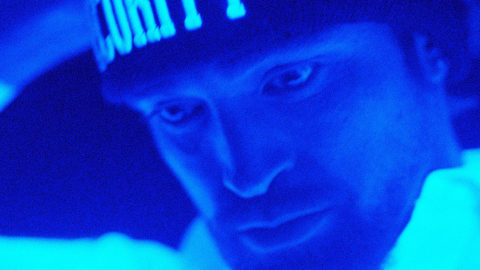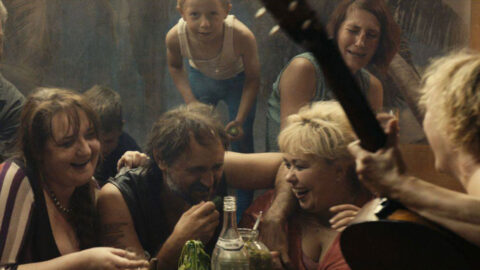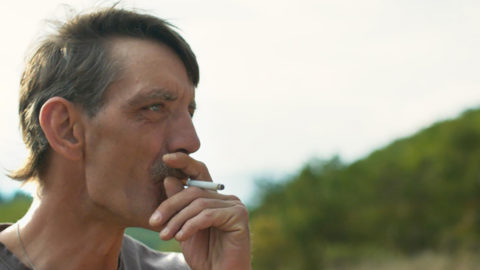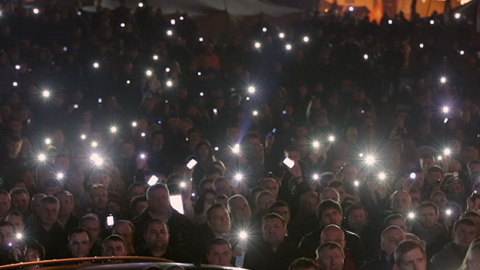Cannes Interview: Sergei Loznitsa
Update: A Gentle Creature has its North American premiere in the New York Film Festival, where it screens October 4 and 5.
Known widely for his work in archival and observational nonfiction, Ukrainian director Sergei Loznitsa has, over the last decade, also established a substantial parallel career in fiction filmmaking. While his documentaries have largely focused on momentous occasions in Russian and Eastern European history, Loznitsa’s dramatic features (which include 2010’s My Joy and 2012’s In the Fog) have afforded him the opportunity to apply similar thematic concerns to more contemporary scenarios. A Gentle Creature, Loznitsa’s latest, further confirms his holistic sense of history and its pervasive present-day reincarnations. When a parcel marked undeliverable returns from the prison where her husband is incarcerated, an anonymous woman (played with stoic, unflagging resolve by Vasilina Makovtseva, the femme douce of the film’s title) begins a harrowing journey into the labyrinthine depths of Russia’s bureaucratic underbelly. Composed as a series of extended tableaux vivants, tracking our heroine’s futile quest to confirm her husband’s whereabouts against an Orwellian stronghold of civic corruption and browbeaten civil servantry, A Gentle Creature is at once Losnitza’s most furiously pitched and painstakingly constructed work to date, moving ahead with an appropriately methodical rigor even as it reaches heights of hallucinogenic madness in its final stretch. It’s a sobering and troubling vision, rendered in vivid strokes by a consummate thinker and master craftsman.
Loznitsa sat down with Film Comment following A Gentle Creature’s premiere in Competition at Cannes to discuss the suppressed state of political cinema in Russia, the importance of aesthetics in his films, and the everyday absurdity of provincial life in the former Soviet Union.
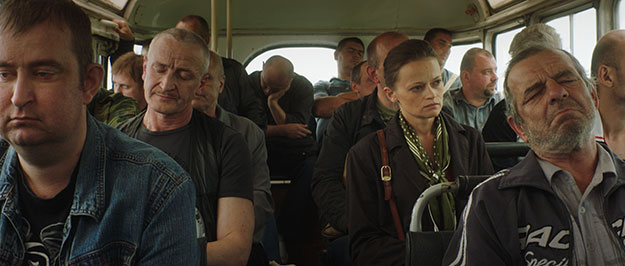
This is one of the more incensed political films that I can remember. What’s the state of political cinema in Russia? How difficult is it to get movies like these made?
Okay, so my film was not made in Russia; it was made in Latvia and is a coproduction of five European countries. In Russia today, I would have thought it impossible to finance and produce a film like this. You can shoot it in Russia, but you cannot finance it in Russia. And so in recent history, perhaps there were one or two films made in Russia with this kind of strong political message, but it’s really a struggle now to think of the titles of those films.
But I wouldn’t say that this film is exclusively a political film. Yes, of course, it has a strong political message, and yes of course the situation I’m describing—the opposition, the relationship between the individual and the state—is political, but I wouldn’t say that it’s exclusively a political film. The situation in which our protagonist finds herself, and all the characters that surround her, everything we see in the film, I would say is deeply rooted in the Russian cultural tradition and the mythology of the place in literature.
Tell me about Daugavpils, the Latvian town where you shot the film.
It’s the capital of eastern Latvia. It’s the territory populated predominantly by ethnic Russians, and it’s quite an old town. For a long while, from the time of the Russian empire, there was a military fortress, and I believe that the town itself was built around this fortress, around the 18th century. Nowadays, part of this fortress is being used as a prison. And also this town is famous for its prisons, which have existed since the empire, and so one of these prisons—prison number two—is actually located on the grounds of the fortress.
The title of the film refers to Dostoevsky’s short story, but its literary sweep suggests many inspirations. What was the writing and research process like?
Well, I haven’t done any special, specific research for this film. I didn’t need to. I’ve read enough books in my lifetime to have this database in my mind already. My initial intention when I started working on the script was to follow Dostoevsky’s plot quite closely, but then as the script progressed, the narrative kind of took over and at a certain point it took a very sharp turn from my initial idea. When I work on a script I don’t have a very clear or strict plan for the narrative; I would say it’s almost automatic writing, so something switches on inside of me that dictates the script, and I just record what comes out. I’ve studied, of course, I’ve read all of these books on how to write a good script, how to write an efficient script that will work—of course I know all that, but I will say, in my case, it just doesn’t work. I could just throw these books away. I write in a different way.
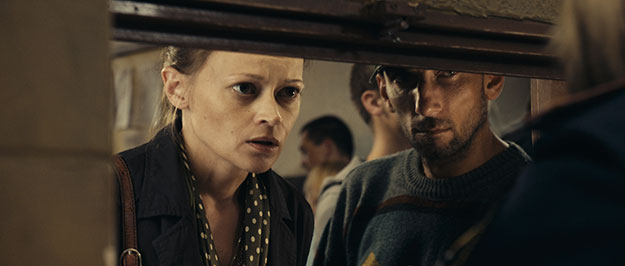
The film makes time for some very intricate detailing of the inspection processes at these facilities. Where did these details come from?
There were a lot of nonprofessional actors who worked on my film. And many of them actually served long prison terms, so they were very familiar with the environment and the procedures. In a way, they also worked as my consultants on the film. And in certain episodes they told me what things had to be changed, and if they noticed some kind of discrepancy, something that wouldn’t happen in real life. And on the linguistic level, I use a lot of this very specific prison jargon used there; it’s their normal language, so I borrowed a lot from this.
Where did you find Vasilina Makovtseva?
Usually when I write I already have in my mind a very clear image of what this or that character should look like. And I remembered an actress I saw on stage, so we called her. And it turned out that she’s a very strong actress with great potential, and her range is really huge. At the same time, when you look at her in real life it’s difficult to believe that such a tiny, delicate woman is capable of having such presence on screen.
There’s an extended dream sequence featuring a dense array of references to Russian society and politics. I imagine many of the political particulars will be lost on English-speaking viewers. What can you tell us about this scene that might not be readily apparent?
Basically what happens there is a kind of gathering, perhaps like a trial, and in the end the verdict that’s delivered to the protagonist is that she’s promised a reward, which is a meeting with her husband. And then having made this promise, they in fact do precisely the opposite and subject her to his execution. So the very simple idea I attempted to convey in this scene is about the nature of power, of the regime. The regime is in fact a joint effort, a joint action of a large group of small, insignificant people. And each individual character contributes to this regime by his daily actions. And each speech that’s pronounced is based, on the newspeak of the Soviet times, and tied to the rituals of Russian tradition, like a folk tradition. So today, a meeting like this can happen on a routine basis in various institutions, establishments, and bodies of government, and of course it’s grotesque—an ironic depiction of something that is very recognizable and almost naturally happening in this space in Russia today.
For example, every year there is a ceremony when the president gives awards to the citizens who distinguish themselves in various areas of life: industry, agriculture, arts, etc. And I based some of the texts I wrote on the speeches from these ceremonies. Basically it’s gibberish, it’s garbage. They say garbage. What I repeat is the ceremony.
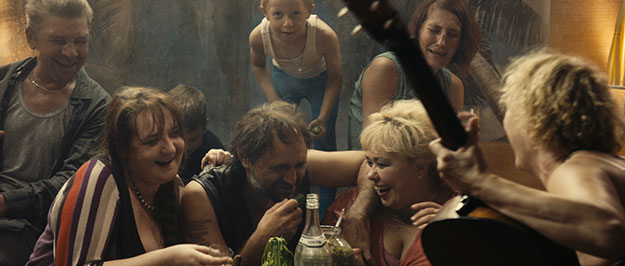
Many of your images seem to condense the depth of the frame as you place people and objects in horizontal tableaux across the frame. How did you and your cinematographer, Oleg Mutu, come to the visual look of the film?
First and foremost I am interested in the aesthetics of the image. So we chose the ratio, which is 2.66:1, so it’s slightly stretched horizontally. And this ratio actually adds some drama to the image. So in terms of composition for every shot, yes, everything is discussed and fixed and arranged. For example, the shots with large numbers of people: they should be distributed in waves and it’s very important to observe this principle of odd and even—there have to be waves of people in odd and even numbers. And obviously it has to be harmonious, so if you look at the image from this point of view you will find there is harmony in every shot.
Jordan Cronk is a critic and programmer based in Los Angeles. He runs the experimental screening series Acropolis Cinema and is co-artistic director of the Locarno in Los Angeles Film Festival.



